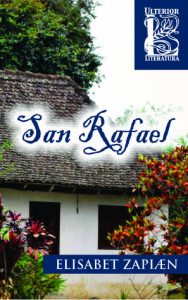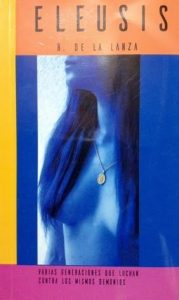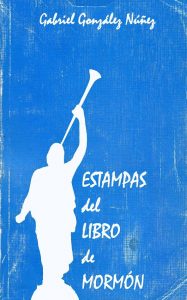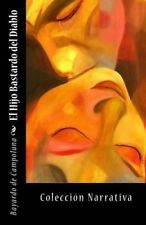By Gabriel González Núñez
Part I of this article can be accessed here. In it, some introductory thoughts were presented, and Argentine authors were surveyed.
 Besides Argentina, another country where Mormon authors are beginning to publish is Mexico. There are two Mormon authors that I know of in this country. The first goes by the pen name Elisabet Zapiæn, but she also publishes under her real name Elizabeth González Torres. She debuted with a novel in 2012 titled San Rafael (Ulterior Editorial). The novel is about a love triangle against the backdrop of a murder mystery in a town called San Rafael. It has no distinctive Mormon features. Zapiæn has also published three short stories in literary journals, none of which have any Mormon elements.
Besides Argentina, another country where Mormon authors are beginning to publish is Mexico. There are two Mormon authors that I know of in this country. The first goes by the pen name Elisabet Zapiæn, but she also publishes under her real name Elizabeth González Torres. She debuted with a novel in 2012 titled San Rafael (Ulterior Editorial). The novel is about a love triangle against the backdrop of a murder mystery in a town called San Rafael. It has no distinctive Mormon features. Zapiæn has also published three short stories in literary journals, none of which have any Mormon elements.
 Another Mexican author is R. de la Lanza. In 2015 he self-published a short story titled “El jerarca” [which can be translated as The Leader], which is a detective story about the murder of a Church employee. In 2016 he published his debut novel Eleusis (published by a group of publishers-in-training under the name Intendencia de las Letras). It tells the story of several generations of Mexican Latter-day Saints, from Mexican-Revolution-era pioneers to modern young single adults in Mexico City. The work is unquestionably of a fine literary quality, and it is definitely a work of Mormon literature. The novel’s portrayal of modern Mexican Mormons as largely a group of hypocrites is likely to be off-putting to some among the more faithful Latter-day Saint readers. De la Lanza has so far written about Mormon topics because, in his own words: “It’s the world I know […] I don’t know anything about drug lords, about other worlds, like the world of labor unions, of large corporations, etc. What I am most familiar with is the world of my brothers and sisters in the Church.”
Another Mexican author is R. de la Lanza. In 2015 he self-published a short story titled “El jerarca” [which can be translated as The Leader], which is a detective story about the murder of a Church employee. In 2016 he published his debut novel Eleusis (published by a group of publishers-in-training under the name Intendencia de las Letras). It tells the story of several generations of Mexican Latter-day Saints, from Mexican-Revolution-era pioneers to modern young single adults in Mexico City. The work is unquestionably of a fine literary quality, and it is definitely a work of Mormon literature. The novel’s portrayal of modern Mexican Mormons as largely a group of hypocrites is likely to be off-putting to some among the more faithful Latter-day Saint readers. De la Lanza has so far written about Mormon topics because, in his own words: “It’s the world I know […] I don’t know anything about drug lords, about other worlds, like the world of labor unions, of large corporations, etc. What I am most familiar with is the world of my brothers and sisters in the Church.”
 Outside of Argentina and Mexico, one might consider Uruguayan authors. Here Rafael Diogo comes to mind. He is an author who has been actively self-publishing since the early nineties. He is a prolific writer, as can be seen by the lengthy list of works he has published since then. He has mostly written non-fiction, including training books and manuals, history books, essays, and essays on LDS doctrine. In terms of literature, he has written poetry, plays, and novels. His literary output includes a poem about carrying Christ’s cross, a play about the birth of Jesus Christ, and a play about the restoration. His novels are historical or didactical, and they do not have Mormon elements per se. All of his books were self-published either on paper or digitally, and now he’s made all of his writings downloadable as free PDFs from his blog.
Outside of Argentina and Mexico, one might consider Uruguayan authors. Here Rafael Diogo comes to mind. He is an author who has been actively self-publishing since the early nineties. He is a prolific writer, as can be seen by the lengthy list of works he has published since then. He has mostly written non-fiction, including training books and manuals, history books, essays, and essays on LDS doctrine. In terms of literature, he has written poetry, plays, and novels. His literary output includes a poem about carrying Christ’s cross, a play about the birth of Jesus Christ, and a play about the restoration. His novels are historical or didactical, and they do not have Mormon elements per se. All of his books were self-published either on paper or digitally, and now he’s made all of his writings downloadable as free PDFs from his blog.
 At this point I should also mention my own work, which includes a number of short stories, but more importantly for this discussion, the self-published book Estampas del Libro de Mormón. The title is hard to translate. In a religious sense an estampa is a Catholic holy card which depicts an image of a saint. In a literary sense, it is a vignette. The title in Spanish aims to reflect the religious and literary meaning. My book’s title follows after Juana de Ibarbourou’s own Estampas de la Biblia, a magnificent little book which contains a set of first-person narratives from Old Testament characters. I tried to do something similar but with characters from the Book of Mormon. The work is unapologetically Mormon. I also wanted to be true to that rich Latin American tradition of experimental writers. It is an attempt to straddle two traditions, if you will.
At this point I should also mention my own work, which includes a number of short stories, but more importantly for this discussion, the self-published book Estampas del Libro de Mormón. The title is hard to translate. In a religious sense an estampa is a Catholic holy card which depicts an image of a saint. In a literary sense, it is a vignette. The title in Spanish aims to reflect the religious and literary meaning. My book’s title follows after Juana de Ibarbourou’s own Estampas de la Biblia, a magnificent little book which contains a set of first-person narratives from Old Testament characters. I tried to do something similar but with characters from the Book of Mormon. The work is unapologetically Mormon. I also wanted to be true to that rich Latin American tradition of experimental writers. It is an attempt to straddle two traditions, if you will.
 Mormon authors can also be found elsewhere, no doubt. One of them is Bayardo de Campoluna. He is a Honduran, self-published author with over 5,000 followers in social media. By 2012 he had published two short story collections, which he soon thereafter pulled off the market because he felt they were not the quality works he wanted them to be. One of these now-disavowed books included the short story “Nadie tiene mayor amor que este” [Greater Love Hath No Man than This], which won the Lira de Oro literary award in Honduras. It was a story about an LDS missionary who saves a woman from getting raped but in the process is himself murdered. In 2012, De Campoluna published his first novel El hijo bastardo del diablo [The Bastard Son of the Devil], and in 2015 he published a short story collection titled Límite difuso [Blurred Lines]. There is no Mormon content in these two works.
Mormon authors can also be found elsewhere, no doubt. One of them is Bayardo de Campoluna. He is a Honduran, self-published author with over 5,000 followers in social media. By 2012 he had published two short story collections, which he soon thereafter pulled off the market because he felt they were not the quality works he wanted them to be. One of these now-disavowed books included the short story “Nadie tiene mayor amor que este” [Greater Love Hath No Man than This], which won the Lira de Oro literary award in Honduras. It was a story about an LDS missionary who saves a woman from getting raped but in the process is himself murdered. In 2012, De Campoluna published his first novel El hijo bastardo del diablo [The Bastard Son of the Devil], and in 2015 he published a short story collection titled Límite difuso [Blurred Lines]. There is no Mormon content in these two works.
So where does this survey leave us?
For starters, on might note that none of these are full-time writers… or even well-known writers. They all need make ends meet outside of writing, and their books are either self-published or published by small, independent presses. There is yet to be a Mormon, as far as I can tell, who can make a living by writing literature, or at least who can be published by the likes of Planeta, Penguin Random House, Santillana, or Anaya.
The next observation is most of what has been produced by these writers collectively is non-Mormon themed. This may be true of LDS writers in English as well, but in the Spanish-speaking world it seems to reflect the reality that there is no such thing as “Mormon literature”, so Latter-day Saints who want to write do so about many things, only some of which are related to Mormonism in any way. All authors surveyed for this post indicated that being LDS is a part of their worldview, whether their writing reflects this or not.
So, in essence, we are very far away from a Mormon literature in Spanish. This may be so because the conditions are not currently given for the rise of a such a literature in that language. There is not now, nor is there likely to ever be, a call from Church leaders to “have Vargas Llosas and Cervanteses of our own”. So the effort will have to respond to market possibilities and not a sense of religious duty, per se. Further, unlike what happened in the United States, there is no Spanish-speaking Mormon corridor where a home-grown literature might arise and then give rise other waves of Mormon literature. Mormon writers are spread out thinly over twenty countries, so it’s unlikely that a single, Spanish-language Mormon market might arise. (This is likely to happen in the United States before it happens everywhere else.) Attempts to get any traction within the Mormon world are likely to fizzle out over distance.
Because of this, I believe that in order for there to be a Mormon literature in Cervantes’ language, you need to have well-known authors first. These authors would have to establish themselves as writers outside of Mormondom and just happen to include Mormon works as part of a larger set of literary offerings. This, by the way, is what happens to some extent with science fiction in Spanish—there are no major science fiction writers in the Spanish-speaking world, but there are a number of major, even canonical, writers who have published elements of science fiction as part of their larger body of work. Take Jorge Luis Borges, who stands tall among the greatest writers in the Spanish language. He wove elements of science fiction and fantasy into his work so seamlessly that he is nearly impossible to fit into any one genre. Following this pattern, one might envision over time a group of Mormon writers who are published by well-established publishing houses and who happen to include Mormon elements as part of a larger cannon. Right now we’re not there. There’s quite a ways to go. But we might yet have Borgeses of our own.
Gabriel González Núñez was born in Montevideo, Uruguay, and has lived in several countries, including Ecuador, Belgium, and the United States. His literary blog–which includes short stories, flash chronicles, and translations–can be accessed here. He lives in Brownsville, Texas, where he trains translators and interpreters at The University of Texas Rio Grande Valley. He is happily married and has, as of right now, two children.

For most of English-speaking Mormon literature history, the main output was poems and largely didactic tales in Church-related magazines like The Improvement Era. Was there a period like that in Spanish-speaking Mormon literature? In journals like El Mensajero (1937-1955) in Argentina and The Liahona (1955-1977) in Mexico?
The point about lacking a Mormon corridor in the Spanish-speaking world is interesting and unfortunate. It sounds like you and several of the other authors spent some time at BYU. Does/can BYU act as a place where Spanish Mormon literature can develop? Does the BYU Spanish & Portuguese Department encourage creative writing, or have a journal where Spanish writing can be published?
I see the BYU Spanish & Portuguese Department’s journal, La Marca Hispanica, has just been reborn as Entremundos. I am told they are making “a pointed attempt to include not just interpretive and analytical scholarship but creative works as well.”
https://www.facebook.com/entremundosbyu/
Andrew, first of all, I appreciate this being posted here.
Regarding your first post, I do not have access to El Mensajero Deseret or the Mexican Liahona, so I wouldn’t know. But I do know from Mario Montani that Máximo Corte published extensively in El Mensajero Deseret. If at some point the Church digitizes those periodicals, I’d be very interested to take a look at them.
As regards, BYU, I studied there. My first short story ever published was published in La Marca Hispánica, which at the time published mostly creative works. BYU certainly has the resources to spear-head some effort in terms of promoting a Mormon literature in Spanish, but I have no clue whether anyone there would be inclined to do so. Additionally, I’m probably the exception to the rule in terms of the authors listed in these two posts. I don’t know that anyone else has been to BYU. And even with me, I’m not really connected to BYU in any real way anymore.
.
I’m so glad you’ve written these, Gabriel. Just having this out and googlable might lead to new and exciting things.
Thank you, Theric. I hope so as well. If nothing else, I’d love to hear of any other Mormon authors publishing in Spanish. And maybe someone can write something along these lines for Portuguese, as well.
pasar taruhan